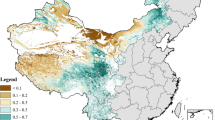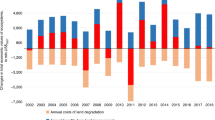Abstract
Payment for ecosystem services (PES) programmes seek to promote conservation via payments for desired resource-use behaviours. While PES has been found to produce some ecological and livelihood benefits, an understudied concern is what happens when payments stop. We assess how households’ land-use behaviours changed in response to a temporary gap in payments and subsequent payment uncertainty in a programme in Ecuador, which paid communities to reduce their grazing on their communal lands. In 2015, after six years in operation, the programme lost funds and stopped payments. These resumed in 2017, but participants were only partially repaid retroactively, and future payments remained uncertain due to funding instability. Using a difference-in-difference modelling approach, we compare household grazing behaviour between communities in the programme and a set of control communities over ten years before PES payments, during PES payments and after the gap in payments in a period where participants were still owed at least one past payment and future payments were uncertain (n = 871 households). We find that grazing was significantly reduced by almost 20% over the ten-year period and that households continued to refrain from grazing even after experiencing payment loss. Our results demonstrate the importance of aligning programme objectives with community conservation and livelihood goals. Our discussion suggests how these conditions may interact with PES to prompt sustained behavioural change.
This is a preview of subscription content, access via your institution
Access options
Access Nature and 54 other Nature Portfolio journals
Get Nature+, our best-value online-access subscription
$29.99 / 30 days
cancel any time
Subscribe to this journal
Receive 12 digital issues and online access to articles
$119.00 per year
only $9.92 per issue
Buy this article
- Purchase on Springer Link
- Instant access to full article PDF
Prices may be subject to local taxes which are calculated during checkout

Similar content being viewed by others
Data availability
Survey data are available at https://scholarworks.seattleu.edu/env-std-data/1/. Field páramo assessment data are available from the corresponding author on reasonable request as these field data are sensitive for the respective communities.
Code availability
Stata code for regression analysis is available at https://scholarworks.seattleu.edu/env-std-data/1/.
References
Ferraro, P. J. The future of payments for environmental services. Conserv. Biol. 25, 1134–1138 (2011).
Milder, J. C., Scherr, S. J. & Bracer, C. Trends and future potential of payment for ecosystem services to alleviate rural poverty in developing countries. Ecol. Soc. 15, 4 (2010).
McAfee, K. The contradictory logic of global ecosystem services markets. Dev. Change 43, 105–131 (2012).
Redford, K. H. & Adams, W. M. Payment for ecosystem services and the challenge of saving nature. Conserv. Biol. 23, 785–787 (2009).
Wunder, S. When payments for environmental services will work for conservation. Conserv. Lett. 6, 230–237 (2013).
Blundo Canto, G. et al. The different dimensions of livelihood impacts of payments for environmental services (PES) schemes: a systematic review. Ecol. Econ. 149, 160–183 (2018).
Liu, Z. & Kontoleon, A. Meta-analysis of livelihood impacts of payments for environmental services programmes in developing countries. Ecol. Econ. 149, 48–61 (2018).
Börner, J. et al. The effectiveness of payments for environmental services. World Dev. 96, 359–374 (2017).
Pagiola, S., Honey-Rosés, J. & Freire-González, J. Assessing the permanence of land-use change induced by payments for environmental services: evidence from Nicaragua. Trop. Conserv. Sci. 13, 1940082920922676 (2020).
Rasch, S., Wünscher, T., Casasola, F., Ibrahim, M. & Storm, H. Permanence of PES and the role of social context in the Regional Integrated Silvo-pastoral Ecosystem Management Project in Costa Rica. Ecol. Econ. 185, 107027 (2021).
Snilsveit, B. et al. Incentives for climate mitigation in the land use sector—the effects of payment for environmental services on environmental and socioeconomic outcomes in low‐ and middle‐income countries: a mixed‐methods systematic review. Campbell Syst. Rev. 15, e1045 (2019).
Wunder, S., Börner, J., Ezzine-de-Blas, D., Feder, S. & Pagiola, S. Payments for environmental services: past performance and pending potentials. Annu. Rev. Resour. Econ. 12, 209–234 (2020).
Kronenberg, J. & Hubacek, K. Could payments for ecosystem services create an “ecosystem service curse”? Ecol. Soc. 18, 10 (2013).
Hiedanpää, J. & Bromley, D. W. Payments for ecosystem services: durable habits, dubious nudges, and doubtful efficacy. J. Inst. Econ. 10, 175–195 (2014).
Ezzine-de-Blas, D., Corbera, E. & Lapeyre, R. Payments for environmental services and motivation crowding: towards a conceptual framework. Ecol. Econ. 156, 434–443 (2019).
Fisher, J. No pay, no care? A case study exploring motivations for participation in payments for ecosystem services in Uganda. Oryx 46, 45–54 (2012).
Gomez-Baggethun, E., de Groot, R., Lomas, P. L. & Montes, C. The history of ecosystem services in economic theory and practice: from early notions to markets and payment schemes. Ecol. Econ. 69, 1209–1218 (2010).
Gneezy, U., Meier, S. & Rey-Biel, P. When and why incentives (don’t) work to modify behavior. J. Econ. Perspect. 25, 191–210 (2011).
Kamenica, E. Behavioral economics and psychology of incentives. Annu. Rev. Econ. 4, 427–452 (2012).
Ajzen, I. The theory of planned behavior. Organ. Behav. Hum. Decis. Process. 50, 179–211 (1991).
Deci, E. L., Koestner, R. & Ryan, R. M. A meta-analytic review of experiments examining the effects of extrinsic rewards on intrinsic motivation. Psychol. Bull. 125, 627–668 (1999).
Bremer, L. L. et al. Relational values in evaluations of upstream social outcomes of watershed payment for ecosystem services: a review. Curr. Opin. Environ. Sustain. 35, 116–123 (2018).
McAfee, K. & Shapiro, E. N. Payments for ecosystem services in Mexico: nature, neoliberalism, social movements, and the state. Ann. Assoc. Am. Geogr. 100, 579–599 (2010).
Kerr, J. M., Vardhan, M. & Jindal, R. Incentives, conditionality and collective action in payment for environmental services. Int. J. Commons 8, 595–616 (2014).
Muradian, R. Payments for ecosystem services as incentives for collective action. Soc. Nat. Resour. 26, 1155–1169 (2013).
Shapiro-Garza, E., McElwee, P., Van Hecken, G. & Corbera, E. Beyond market logics: payments for ecosystem services as alternative development practices in the global south. Dev. Change 51, 3–25 (2020).
Ostrom, E. A general framework for analyzing sustainability of social-ecological systems. Science 325, 419–422 (2009).
Hayes, T., Grillos, T., Bremer, L. L., Murtinho, F. & Shapiro, E. Collective PES: more than the sum of individual incentives. Environ. Sci. Policy 102, 1–8 (2019).
Deci, E. L. & Ryan, R. M. Handbook of Self-determination Research (Univ. Rochester Press, 2002).
Frey, B. S. & Jegen, R. Motivation crowding theory. J. Econ. Surv. 15, 589–611 (2001).
Rode, J., Gómez-Baggethun, E. & Krause, T. Motivation crowding by economic incentives in conservation policy: a review of the empirical evidence. Ecol. Econ. 117, 270–282 (2015).
Andersson, K. P. et al. Experimental evidence on payments for forest commons conservation. Nat. Sustain. 1, 128–135 (2018).
Pagiola, S., Honey-Rosés, J. & Freire-González, J. Evaluation of the permanence of land use change induced by payments for environmental services in Quindío, Colombia. PLoS ONE 11, e0147829 (2016).
Farley, K. A., Anderson, W. G., Bremer, L. L. & Harden, C. P. Compensation for ecosystem services: an evaluation of efforts to achieve conservation and development in Ecuadorian páramo grasslands. Environ. Conserv. 38, 393–405 (2011).
Buytaert, W. et al. Human impact on the hydrology of the Andean páramos. Earth Sci. Rev. 79, 53–72 (2006).
Hofstede, R. et al. Los Páramos Andinos: ¿Qué Sabemos? Estado de Conocimiento sobre el Impacto del Cabio Climático en el Ecosystema Páramo (IUCN, 2014).
Madriñan, S., Cortes, A. & Richardson, J. Páramo is the world’s fastest evolving and coolest biodiversity hotspot. Front. Genet. 4, 192 (2013).
Farley, K. A., Bremer, L. L., Harden, C. P. & Hartsig, J. Changes in carbon storage under alternative land uses in biodiverse Andean grasslands: implications for payment for ecosystem services. Conserv. Lett. 6, 21–27 (2013).
Hayes, T., Murtinho, F. & Wolff, H. The impact of payments for environmental services on communal lands: an analysis of the factors driving household land-use behavior in Ecuador. World Dev. 93, 427–446 (2017).
Murtinho, F. & Hayes, T. Communal participation in payment for environmental services (PES): unpacking the collective decision to enroll. Environ. Manage. 59, 939–955 (2017).
Hayes, T., Murtinho, F. & Wolff, H. An institutional analysis of payment for environmental services on collectively managed lands in Ecuador. Ecol. Econ. 118, 81–89 (2015).
Herrador-Valencia, D. & Paredes, M. Cambio climático y agricultura de pequeña escala en los Andes ecuatorianos: un estudio sobre percepciones locales y estrategias de adaptación. J. Lat. Am. Geogr. 15, 101–121 (2016).
López, S., Jung, J.-K. & López, M. F. A hybrid-epistemological approach to climate change research: linking scientific and smallholder knowledge systems in the Ecuadorian Andes. Anthropocene 17, 30–45 (2017).
Jampel, C. Cattle-based livelihoods, changes in the taskscape, and human–bear conflict in the Ecuadorian Andes. Geoforum 69, 84–93 (2016).
Gibson, C., Andersson, K., Ostrom, E. & Shivakumar, S. The Samaritan’s Dilemma. The Political Economy of Development Aid (Oxford Univ. Press, 2005).
Riddell, R. C. Does Foreign Aid Really Work? (Oxford Univ. Press, 2008).
Piñeiro, V. et al. A scoping review on incentives for adoption of sustainable agricultural practices and their outcomes. Nat. Sustain. 3, 809–820 (2020).
Ashraf, N., Giné, X. & Karlan, D. Finding missing markets (and a disturbing epilogue): evidence from an export crop adoption and marketing intervention in Kenya. Am. J. Agric. Econ. 91, 973–990 (2009).
Acuerdo Ministerial Número 115 (Ministerio del Ambiente, 2009).
Alix‐Garcia, J. & Wolff, H. Payment for ecosystem services from forests. Annu. Rev. Resour. Econ. 6, 361–380 (2014).
Miteva, D. A., Pattanayak, S. K. & Ferraro, P. J. Evaluation of biodiversity policy instruments: what works and what doesn’t? Oxf. Rev. Econ. Policy 28, 69–92 (2012).
Ostrom, E. Background on the institutional analysis and development framework. Policy Stud. J. 39, 7–27 (2011).
Schaeffer, N. C. & Presser, S. The science of asking questions. Annu. Rev. Sociol. 29, 65–88 (2003).
Thornberry, T. P. & Krohn, M. D. The self-report method for measuring delinquency and crime. Crim. Justice 4, 33–83 (2000).
Raphael, K. Recall bias: a proposal for assessment and control. Int. J. Epidemiol. 16, 167–170 (1987).
Peralvo, M. Protocolo de Levantamiento de Puntos en Campo (CONDESAN, 2013).
Imbens, G. W. & Wooldridge, J. M. Recent developments in the econometrics of program evaluation. J. Econ. Lit. 47, 5–86 (2009).
Cameron, A. C., Gelbach, J. B. & Miller, D. L. Bootstrap-based improvements for inference with clustered errors. Rev. Econ. Stat. 90, 414–427 (2008).
Meyer, B. D. Natural and quasi-experiments in economics. J. Bus. Econ. Stat. 13, 151–161 (1995).
Altonji, J. G., Elder, T. E. & Taber, C. R. Selection on Observed and Unobserved Variables: Assessing the Effectiveness of Catholic Schools (NBER, 2000).
Acknowledgements
This study was supported by grants from the National Science Foundation: grants SES #1156271 (T.H., F.M. and H.W.) and SES #1734051 (T.H. and F.M.). We thank the Ecuadorian Environmental Ministry (MAE), which was crucial in facilitating fieldwork. We give special recognition to M. Bustamante, M. Peralvo, C. Felix, M. Garcia and L. Trujillo for their assistance in data gathering and analysis. Finally, we thank the residents of the study communities who welcomed us into their homes and facilitated our visits to their páramo.
Author information
Authors and Affiliations
Contributions
T.H. and F.M. conceived the project and developed the analysis approach. T.H., H.W and F.M. analysed the survey and field assessment data. M.F.L.-S. and J.S. gathered and analysed the aerial and satellite images. J.S. conducted the páramo field assessment. T.H., F.M. and H.W. wrote the paper.
Corresponding author
Ethics declarations
Competing interests
The authors declare no competing interests.
Additional information
Peer review information Nature Sustainability thanks Krister Andersson, Julian Rode and the other, anonymous, reviewer(s) for their contribution to the peer review of this work.
Publisher’s note Springer Nature remains neutral with regard to jurisdictional claims in published maps and institutional affiliations.
Supplementary information
Supplementary Information
Supplementary Methods, Figs. 1–4, Tables 1–8, Note, Discussion and references.
Rights and permissions
About this article
Cite this article
Hayes, T., Murtinho, F., Wolff, H. et al. Effectiveness of payment for ecosystem services after loss and uncertainty of compensation. Nat Sustain 5, 81–88 (2022). https://doi.org/10.1038/s41893-021-00804-5
Received:
Accepted:
Published:
Issue Date:
DOI: https://doi.org/10.1038/s41893-021-00804-5
This article is cited by
-
Sustained participation in a Payments for Ecosystem Services program reduces deforestation in a Mexican agricultural frontier
Scientific Reports (2023)
-
When payments for ecosystem conservation stop
Nature Sustainability (2021)



